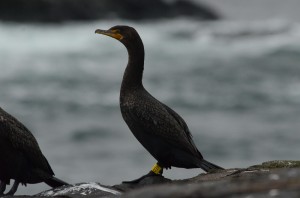Note on banded cormorant:
The bird (KC0) was banded as an adult at a breeding colony on East Sand Island in the Columbia River estuary (near Astoria, OR) in May 2013 by the group, Bird Research Northwest (http://www.birdresearchnw.org
http://news.
On Dec . 30, 2014 the following details were sent to us after we reported it to the
The North American Bird Banding Program
Banding Data returned after reporting:
Band Number :1128-01387 KC0
Species: Double-Crested Cormorant
Age of Bird : Hatched in 2011 or earlier
Banded : 05/31/2013 Sex Unknown
Location: East Sand Island, 2.4 KM West-Southwest of Chinook, WA, Clatsop county , Oregon USA (Coordinates: LAT: 46.25833; LON: -123.975 )
Bander Dr. Daniel D. Roby Oregon Cooperative WRU Oregon State University 104 Nasgh Hall Corvallis OR 97331 3803
Encounter Data
Location 2 mi SSE of Rocky Point, British Columbia, Canada
Encountered 12/13/2014
Desc: Race Rocks Ecological Reserve
————————————————————————————
Info from : BandReports@usgs.gov
The North American Bird Banding Program
Bird banding is important for studying the movement, survival and behavior of birds. About 60 million birds representing hundreds of species have been banded in North America since 1904. About 4 million bands have been recovered and reported.
Data from banded birds are used in monitoring populations, setting hunting regulations, restoring endangered species, studying effects of environmental contaminants, and addressing such issues as Avian Influenza, bird hazards at airports, and crop depredations. Results from banding studies support national and international bird conservation programs such as Partners in Flight, the North American Waterfowl Management Plan, and Wetlands for the Americas. The North American Bird Banding Program is under the general direction of the U.S. Geological Survey and the Canadian Wildlife Service. Cooperators include the U.S. Fish and Wildlife Service, Mexico’s National Commission for the Knowledge and Use of Biodiversity and Secretary of the Environment and Natural Resources; other federal, state and provincial conservation agencies; universities; amateur ornithologists; bird observatories; nature centers; nongovernmental organizations such as Ducks Unlimited and the National Audubon Society; environmental consulting firms and other private sector businesses. However, the most important partner in this cooperative venture is you, the person who voluntarily reported a recovered band. Thank you for your help.
U.S. Geological Survey
Canadian Wildlife Service
Please Report Bands at www.reportband.gov or call 1-800-327-BAND
Direct reporting form we used can be found at:
https://www.pwrc.usgs.gov/BBL/

